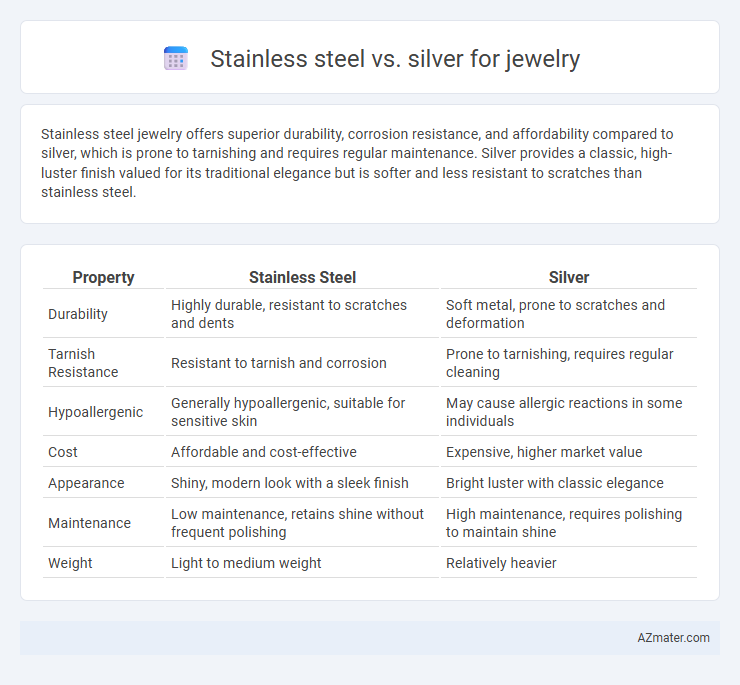Stainless steel jewelry offers superior durability, corrosion resistance, and affordability compared to silver, which is prone to tarnishing and requires regular maintenance. Silver provides a classic, high-luster finish valued for its traditional elegance but is softer and less resistant to scratches than stainless steel.
Table of Comparison
| Property | Stainless Steel | Silver |
|---|---|---|
| Durability | Highly durable, resistant to scratches and dents | Soft metal, prone to scratches and deformation |
| Tarnish Resistance | Resistant to tarnish and corrosion | Prone to tarnishing, requires regular cleaning |
| Hypoallergenic | Generally hypoallergenic, suitable for sensitive skin | May cause allergic reactions in some individuals |
| Cost | Affordable and cost-effective | Expensive, higher market value |
| Appearance | Shiny, modern look with a sleek finish | Bright luster with classic elegance |
| Maintenance | Low maintenance, retains shine without frequent polishing | High maintenance, requires polishing to maintain shine |
| Weight | Light to medium weight | Relatively heavier |
Introduction to Stainless Steel and Silver Jewelry
Stainless steel jewelry offers exceptional durability, corrosion resistance, and affordability, making it ideal for everyday wear and hypoallergenic for sensitive skin. Silver jewelry, particularly sterling silver composed of 92.5% pure silver, provides timeless elegance and a bright, reflective finish but requires regular polishing to prevent tarnishing. Both materials cater to different style preferences and maintenance needs, with stainless steel favored for modern, low-maintenance designs and silver prized for its classic, luxurious appeal.
Material Composition and Properties
Stainless steel jewelry is composed primarily of iron, carbon, and chromium, offering high corrosion resistance and durability due to its alloy structure. Silver jewelry, typically made from sterling silver (92.5% pure silver mixed with copper), provides a softer and more malleable composition prone to tarnishing over time. The inherent hardness and resistance to oxidation make stainless steel a more long-lasting choice, while silver offers a classic luster with a need for regular polishing.
Appearance and Aesthetic Differences
Stainless steel jewelry offers a modern, sleek appearance with a polished, reflective finish that resists tarnishing and maintains its shine over time. Silver jewelry provides a classic, bright white luster that can develop a natural patina, adding vintage charm but requiring regular polishing to prevent tarnish. The aesthetic difference lies in stainless steel's contemporary durability and subtle grayish tone versus silver's traditional brilliance and warm elegance.
Durability and Scratch Resistance
Stainless steel offers superior durability and scratch resistance compared to silver, making it an ideal choice for everyday jewelry that withstands impact and wear. Silver tends to be softer and more prone to scratches and tarnishing, requiring frequent polishing and careful handling. Jewelry crafted from stainless steel maintains its shine and structural integrity longer, especially in active or harsh environments.
Tarnish and Corrosion Resistance
Stainless steel offers superior tarnish and corrosion resistance compared to silver, making it ideal for everyday jewelry exposed to moisture and sweat. Silver, prone to oxidization, often requires regular polishing to maintain its shine and prevent tarnish buildup. Stainless steel's chromium content forms a protective layer that inhibits rust and discoloration, ensuring longevity with minimal maintenance.
Hypoallergenic Qualities and Skin Sensitivity
Stainless steel jewelry is highly valued for its hypoallergenic properties, as it contains minimal nickel and resists tarnishing, making it ideal for sensitive skin. Silver, particularly sterling silver, can cause allergic reactions in individuals sensitive to the alloy's copper content or trace metals. Choosing stainless steel reduces risks of skin irritation and allergic contact dermatitis, providing a durable and skin-friendly alternative for everyday wear.
Maintenance and Cleaning Requirements
Stainless steel jewelry requires minimal maintenance due to its resistance to tarnish, rust, and corrosion, making cleaning as simple as wiping with a damp cloth or mild soap solution. Silver jewelry demands more frequent care to prevent tarnishing, often requiring polishing with a special silver cloth and periodic use of anti-tarnish solutions to maintain its shine. Stainless steel's durability and low upkeep make it ideal for everyday wear, whereas silver's maintenance needs suit those seeking a traditional, elegant appearance despite extra care.
Cost Comparison: Stainless Steel vs Silver
Stainless steel jewelry is significantly more affordable than silver, with prices often ranging from 70-90% less due to lower material and production costs. Silver, especially sterling silver, involves higher expenses because of precious metal value and intricate craftsmanship, driving up the market price. Long-term cost-effectiveness favors stainless steel for durability and minimal maintenance, while silver may require polishing and care, increasing overall ownership costs.
Environmental Impact and Sustainability
Stainless steel jewelry offers a more eco-friendly option due to its durability, recyclability, and lower environmental footprint from mining and production compared to silver, which requires intensive mining operations that can contribute to habitat destruction and water pollution. The lifespan of stainless steel reduces the need for frequent replacements, lessening waste, whereas silver tarnishes and often necessitates chemical cleaning, impacting ecological systems. Choosing stainless steel supports sustainable fashion by minimizing resource depletion and promoting long-term use.
Choosing the Right Metal for Your Jewelry
Stainless steel offers excellent durability, corrosion resistance, and affordability, making it ideal for everyday jewelry that resists tarnishing and scratching. Silver, prized for its classic luster and hypoallergenic properties, suits those seeking a more traditional and elegant appearance despite requiring regular polishing to prevent oxidation. Choosing the right metal depends on lifestyle, budget, and maintenance preference, with stainless steel favored for active wearers and silver preferred for timeless, sophisticated jewelry.

Infographic: Stainless steel vs Silver for Jewelry
 azmater.com
azmater.com